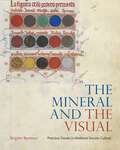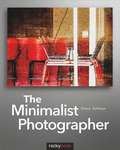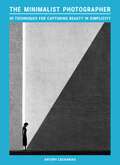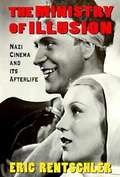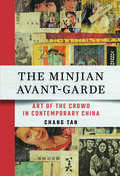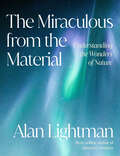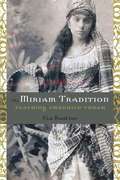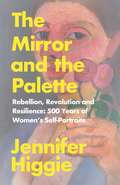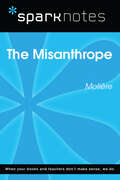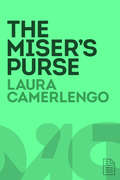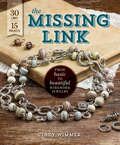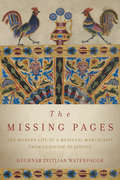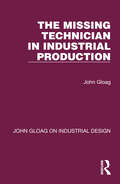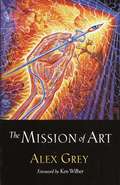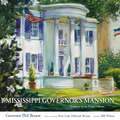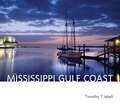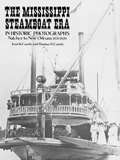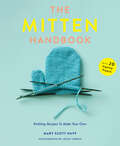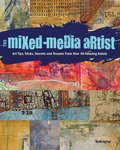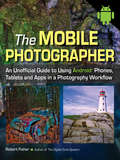- Table View
- List View
The Mineral and the Visual: Precious Stones in Medieval Secular Culture
by Brigitte BuettnerOpulent jeweled objects ranked among the most highly valued works of art in the European Middle Ages. At the same time, precious stones prompted sophisticated reflections on the power of nature and the experience of mineralized beings. Beyond a visual regime that put a premium on brilliant materiality, how can we account for the ubiquity of gems in medieval thought?In The Mineral and the Visual, art historian Brigitte Buettner examines the social roles, cultural meanings, and active agency of precious stones in secular medieval art. Exploring the layered roles played by gems in aesthetic, ideological, intellectual, and economic practices, Buettner focuses on three significant categories of art: the jeweled crown, the pictorialized lapidary, and the illustrated travel account. The global gem trade brought coveted jewels from the Indies to goldsmiths’ workshops in Paris, fashionable bodies in London, and the crowns of kings across Europe, and Buettner shows that Europe’s literal and metaphorical enrichment was predicated on the importation of gems and ideas from Byzantium, the Islamic world, Persia, and India.Original, transhistorical, and cross-disciplinary, The Mineral and the Visual engages important methodological questions about the work of culture in its material dimension. It will be especially useful to scholars and students interested in medieval art history, material culture, and medieval history.
The Minimalist Photographer
by Steve JohnsonThis book covers photography from a minimalist perspective, proving that it is possible to take very good photographs with relatively cheap equipment. The minimalist process emphasizes the importance of first knowing what you want to achieve as a photographer and then choosing the most effective equipment, subject matter, and general approach to meet your goals. The minimalist photographer works with the idea that the brain and the eye are far more important than the camera. Author Steve Johnson begins by asking you, the reader, to look inward and make the connections between your nature and your photography. Why do you want to take photographs and what subject matter are you attracted to? What type of photographer are you now and what type of photographer would you like to become? These are important questions to consider when deciding what approach works best for you. In subsequent chapters, you'll learn about the equipment and workflow of a minimalist photographer as Johnson discusses the strengths and weaknesses of various types of cameras and explains why the biggest or most expensive piece of equipment is not always the best. He also addresses the importance of lighting and teaches you how to achieve effective lighting without spending a lot of money. Also included are discussions about aesthetics and composition, as well as a brief history of photography and the future of the art form.
The Minimalist Photographer: 50 techniques for capturing beauty in simplicity
by Antony ZachariasFind out how to transform the ordinary into something extraordinary with this guide to minimalist photography. With advice on composition, balance, shape and texture, this book takes inspiration from the masters of minimalism to demonstrate how stripping a subject down to its very essence can help you craft beautifully bold and unique images.Illustrated with the finest examples of the style from the likes of Fan Ho, Imogen Cunningham, Michael Kenna, Berenice Abbott, William Eggleston and Horst P. Horst, this book guides you through the key techniques that define minimalism and provides easy-to-follow advice for how to create your own minimalist images that are visually striking in their simplicity.
The Minimalist Photographer: 50 techniques for capturing beauty in simplicity
by Antony ZachariasFind out how to transform the ordinary into something extraordinary with this guide to minimalist photography. With advice on composition, balance, shape and texture, this book takes inspiration from the masters of minimalism to demonstrate how stripping a subject down to its very essence can help you craft beautifully bold and unique images.Illustrated with the finest examples of the style from the likes of Fan Ho, Imogen Cunningham, Michael Kenna, Berenice Abbott, William Eggleston and Horst P. Horst, this book guides you through the key techniques that define minimalism and provides easy-to-follow advice for how to create your own minimalist images that are visually striking in their simplicity.
The Ministry of Illusion: Nazi Cinema and Its Afterlife
by Eric RentschlerEric Rentschler, America's leading scholar of National Socialist cinema, has produced a compact compendium of everything you wanted to know about Nazi filmdom but were afraid to ask. This extensively researched and well written book contains fascinating anecdotal information. It provides a delightful browsing in bits and pieces.
The Minjian Avant-Garde: Art of the Crowd in Contemporary China
by Chang TanThe Minjian Avant-Garde studies how experimental artists in China mixed with, brought changes to, and let themselves be transformed by minjian, the volatile and diverse public of the post-Mao era. Departing from the usual emphasis on art institutions, global markets, or artists' communities, Chang Tan proposes a new analytical framework in the theories of socially engaged art that stresses the critical agency of participants, the affective functions of objects, and the versatility of the artists in diverse sociopolitical spheres.Drawing from hitherto untapped archival materials and interviews with the artists, Tan challenges the views of Chinese artists as either dissidents or conformists to the regime and sees them as navigators and negotiators among diverse political discourses and interests. She questions the fetishization of marginalized communities among practitioners of progressive art and politics, arguing that the members of minjian are often more complex, defiant, and savvy than the elites would assume. The Minjian Avant-Garde critically assesses the rise of populism in both art and politics and show that minjian could constitute either a democratizing or a coercive force.This book was published with generous support from the George Dewey and Mary J. Krumrine Endowment.
The Miracle of Clarence W. Jones & HCJB
by Lois Neely"Go south with radio," God said to Clarence Wesley Jones. So C. W. went south--to Ecuador. Come up to this mountain," God said. Clarence Jones ascended the mountain and perched his tiny radio operation in Quito, the city at the "top of the world." Lord, C. W. prayed then, give me this mountain. And so it was that in 1931, in a humble sheepshed rigged with a 250-watt transmitter and antenna wire, a Christmas program was broadcast to a total of just thirteen receiving sets, and HCJB was born. It was the advent of missionary radio. Come Up to This Mountain is the inspiring story of HCJB and the pioneering missionary spirit of C. W. Jones. A man of dreams, relentless energy, and immense practicality, C. W. Jones took that "soft whisper of the Andes" and, through hardship and tragedy, built it into a massive 500,000-watt radio center, a "mighty shout echoing around the globe." Give me this mountain, said C. W. Jones. And God gave him the world.
The Miraculous from the Material: Understanding the Wonders of Nature
by Alan LightmanA gorgeously illustrated exploration of the science behind the universe&’s most stunning natural phenomena—from atoms and parameciums to rainbows, snowflakes, spider webs, the rings of Saturn, galaxies, and moreNature is capable of extraordinary phenomena. Standing in awe of those phenomena, we experience a feeling of connection to the cosmos. For acclaimed physicist and novelist Alan Lightman, just as remarkable is that all of what we see around us—soap bubbles, scarlet ibises, shooting stars—are made out of the same material stuff and obey the same rules and laws. This is what Lightman calls &“spiritual materialism,&” the belief that we can embrace spiritual experiences without letting go of our scientific worldview.Pairing 36 beautiful, full-color photos evoking some of nature&’s most awe-inspiring phenomena with accessible and lyrical personal essays, The Miraculous from the Material explores the fascinating science underlying the natural world. Why do rainbows make an arc? Why does a particular waterfall at Yosemite National Park sometimes glow like it&’s on fire? How does a hummingbird fly? The world has so many things to marvel at—and the science is just as fascinating.Lightman&’s imagination travels from the world of atoms and molecules to the animal kingdom, from places like Ha Long Bay, Vietnam and the Grand Canyon out to the solar system and beyond, illuminating the majesty of the cosmos and the remarkable science behind it. The Miraculous from the Material is a stunning, soaring ode to the beauty and wonder around us, and the perfect holiday gift for photography aficionados, life-long learners, and admirers of the natural world.
The Mirage of America in Contemporary Italian Literature and Film
by Barbara AlfanoThe Mirage of America in Contemporary Italian Literature and Film explores the use of images associated with the United States in Italian novels and films released between the 1980s and the 2000s. In this study, Barbara Alfano looks at the ways in which the individuals portrayed in these works - and the intellectuals who created them - confront the cultural construct of the American myth. As Alfano demonstrates, this myth is an integral part of Italians' discourse to define themselves culturally - in essence, Italian intellectuals talk about America often for the purpose of talking about Italy.The book draws attention to the importance of Italian literature and film as explorations of an individual's ethics, and to how these productions allow for functioning across cultures. It thus differentiates itself from other studies on the subject that aim at establishing the relevance and influence of American culture on Italian twentieth-century artistic representations.
The Miriam Tradition: Teaching Embodied Torah
by Cia SautterThe Miriam Tradition works from the premise that religious values form in and through movement, with ritual and dance developing patterns for enacting those values. Cia Sautter considers the case of Sephardic Jewish women who, following in the tradition of Miriam the prophet, performed dance and music for Jewish celebrations and special occasions. She uses rabbinic and feminist understandings of the Torah to argue that these women, called tanyaderas, "taught" Jewish values by leading appropriate behavior for major life events. Sautter considers the religious values that are in music and dance performed by tanyaderas and examines them in conjunction with written and visual records and evidence from dance and music traditions. Explaining the symbolic gestures and motions encoded in dances, Sautter shows how rituals display deeply held values that are best expressed through the body. The book argues that the activities of women in other religions might also be examined for their embodiment and display of important values, bringing forgotten groups of women back into the historical record as important community leaders
The Mirror and the Palette: Rebellion, Revolution and Resilience: 500 Years of Women's Self-Portraits
by Jennifer HiggieHer story weaves in and out of time and place. She's Frida Kahlo, Loïs Mailou Jones and Amrita Sher-Gil en route to Mexico City, Paris or Bombay. She's Suzanne Valadon and Gwen John, craving city lights, the sea and solitude; she's Artemisia Gentileschi striding through the streets of Naples and Paula Modersohn-Becker in Worpswede. She's haunting museums in her paint-stained dress, scrutinising how El Greco or Titian or Van Dyck or Cézanne solved the problems that she too is facing. She's railing against her corsets, her chaperones, her husband and her brothers; she's hammering on doors, dreaming in her bedroom, working day and night in her studio. Despite the immense hurdles that have been placed in her way, she sits at her easel, picks up a mirror and paints a self-portrait because, as a subject, she is always available. Until the twentieth century, art history was, in the main, written by white men who tended to write about other white men. The idea that women in the West have always made art was rarely cited as a possibility. Yet they have - and, of course, continue to do so - often against tremendous odds, from laws and religion to the pressures of family and public disapproval. In THE MIRROR AND THE PALETTE, Jennifer Higgie introduces us to a cross-section of women artists who embody the fact that there is more than one way to understand our planet, more than one way to live in it and more than one way to make art about it. Spanning 500 years, biography and cultural history intertwine in a narrative packed with tales of rebellion, adventure, revolution, travel and tragedy enacted by women who turned their back on convention and lived lives of great resilience, creativity and bravery. This is a dazzlingly original and ambitious book by one of the most well-respected art critics at work today.
The Mirror and the Palette: Rebellion, Revolution, And Resilience: Five Hundred Years Of Women's Self Portraits
by Jennifer HiggieA dazzlingly original and ambitious book on the history of female self-portraiture by one of today's most well-respected art critics.Her story weaves in and out of time and place. She's Frida Kahlo, Loïs Mailou Jones and Amrita Sher-Gil en route to Mexico City, Paris or Bombay. She's Suzanne Valadon and Gwen John, craving city lights, the sea and solitude; she's Artemisia Gentileschi striding through the streets of Naples and Paula Modersohn-Becker in Worpswede. She's haunting museums in her paint-stained dress, scrutinising how El Greco or Titian or Van Dyck or Cézanne solved the problems that she too is facing. She's railing against her corsets, her chaperones, her husband and her brothers; she's hammering on doors, dreaming in her bedroom, working day and night in her studio. Despite the immense hurdles that have been placed in her way, she sits at her easel, picks up a mirror and paints a self-portrait because, as a subject, she is always available. Until the twentieth century, art history was, in the main, written by white men who tended to write about other white men. The idea that women in the West have always made art was rarely cited as a possibility. Yet they have - and, of course, continue to do so - often against tremendous odds, from laws and religion to the pressures of family and public disapproval. In The Mirror and the Palette, Jennifer Higgie introduces us to a cross-section of women artists who embody the fact that there is more than one way to understand our planet, more than one way to live in it and more than one way to make art about it. Spanning 500 years, biography and cultural history intertwine in a narrative packed with tales of rebellion, adventure, revolution, travel and tragedy enacted by women who turned their back on convention and lived lives of great resilience, creativity and bravery.
The Misanthrope (SparkNotes Literature Guide Series)
by SparkNotesThe Misanthrope (SparkNotes Literature Guide) by Moliere Making the reading experience fun! Created by Harvard students for students everywhere, SparkNotes is a new breed of study guide: smarter, better, faster. Geared to what today's students need to know, SparkNotes provides: *Chapter-by-chapter analysis *Explanations of key themes, motifs, and symbols *A review quiz and essay topicsLively and accessible, these guides are perfect for late-night studying and writing papers
The Miser's Purse
by Laura CamerlengoOriginally written as a thesis for the Parsons/Cooper-Hewitt MA program, The Miser's Purse by Laura Camerlengo, a Curatorial Fellow at the Philadelphia Museum of Art, tells the compelling story of how a small decorative purse became deeply embedded in nineteenth-century Victorian popular culture.<P><P> Known at the time as long purses, gentlemen's purses or simply purses, they came to be called "miser's purses" because their diminutive openings made it difficult to retrieve coins. References to miser's purses in women's magazines and etiquette guides reveal that they were given as gifts or sold at charitable fundraisers, and these social uses were adapted by many artists and writers in their portrayals of society.DesignFile is the new line of e-books on topics and trends in design published by the Cooper-Hewitt, Smithsonian Design Museum. There will be six to twelve titles published annually, each ranging in length from 7,500 to 20,000 words. Building a consortium with institutional partners and design practitioners, Cooper-Hewitt's series will bridge the academic, museum, design, and publishing worlds. Inaugural members of the e-book consortium are Parsons The New School for Design and the School of Visual Arts.
The Missing Link: From Basic to Beautiful Wirework Jewelry
by Cindy WimmerExplore the most fundamental and versatile--yet overlooked--component of jewelry design-the wire link! Unlike many transient jewelry fads, it is one aspect of jewelry making that is consistent and relevant to nearly every style. Get all the details of essential tools and wire techniques as well as a collection of 30 custom links and step-by-step illustrated instructions for creating them. Join a variety of contributors that have created 15 jewelry projects, each incorporating one or more of author Cindy Wimmer's links. You'll see how any single link holds limitless design and functional possibilities. In addition to creating different links, Cindy will show you how to create different effects with the same link design by using or combining different colored wire, changing wire gauge, or changing the size of the link itself.
The Missing Pages: The Modern Life of a Medieval Manuscript, from Genocide to Justice
by Heghnar Zeitlian WatenpaughIn 2010, the world's wealthiest art institution, the J. Paul Getty Museum, found itself confronted by a century-old genocide. The Armenian Church was suing for the return of eight pages from the Zeytun Gospels, a manuscript illuminated by the greatest medieval Armenian artist, Toros Roslin. Protected for centuries in a remote church, the holy manuscript had followed the waves of displaced people exterminated during the Armenian genocide. Passed from hand to hand, caught in the confusion and brutality of the First World War, it was cleaved in two. Decades later, the manuscript found its way to the Republic of Armenia, while its missing eight pages came to the Getty. The Missing Pages is the biography of a manuscript that is at once art, sacred object, and cultural heritage. Its tale mirrors the story of its scattered community as Armenians have struggled to redefine themselves after genocide and in the absence of a homeland. Heghnar Zeitlian Watenpaugh follows in the manuscript's footsteps through seven centuries, from medieval Armenia to the killing fields of 1915 Anatolia, the refugee camps of Aleppo, Ellis Island, and Soviet Armenia, and ultimately to a Los Angeles courtroom. Reconstructing the path of the pages, Watenpaugh uncovers the rich tapestry of an extraordinary artwork and the people touched by it. At once a story of genocide and survival, of unimaginable loss and resilience, The Missing Pages captures the human costs of war and persuasively makes the case for a human right to art.
The Missing Technician in Industrial Production (John Gloag On Industrial Design Ser.)
by John GloagOriginally published in 1944, The Missing Technician shows how Industrial Design must begin at the very first stages of planning a product. The procedure of a design research committee is outlined – a type of practical co-ordination of the work of industrial designers and production technicians which proved highly effective. The value of materials like aluminium and plastic are emphasized, but equally the importance of glass and cast iron is stressed, especially when handled in new ways that 20th Century techniques made possible.
The Mission of Art
by Ken Wilber Alex GreyThis is an inspirational book about art's power to bring about personal catharsis and spiritual awakening. Alex Grey's reflections combine his extensive knowledge of art history and his own first-hand experiences in creating art on the boundaries of consciousness. Included are practical techniques and exercises that can be used to explore the spiritual dimension of art. Challenging and thought-provoking, The Mission of Art will be enjoyed by everyone who has ever contemplated the deeper purpose of artistic expression.
The Mississippi Governor's Mansion: Memories of the People's Home
by Phil BryantWelcoming its first executive in 1842, the Mississippi Governor’s Mansion is the second-oldest continuously occupied governor’s residence in the United States. The Mansion is both a public building open for tours and the private residence of the governor and his family. In this unique book, readers are invited to explore the entirety of the building, from the attic to the garage and everything in between. The Mississippi Governor’s Mansion: Memories of the People’s Home is the first book of its kind dedicated to images and stories about the Governor’s Mansion. The volume reveals Governor Phil Bryant’s profound respect for the office he holds and his deep appreciation for the National Historic Landmark in which he resides. Through his personal, often touching reflections, Governor Bryant pays tribute to former governors, their families, and the many public servants who have dedicated their lives to taking care of this beautiful Greek Revival masterpiece. More than sixty elegant watercolor paintings by noted Mississippi artist Bill Wilson accompany the governor’s stories. Wilson captures the beauty and majesty of the home, its furnishings, and the restored historic grounds. The volume also features a personal foreword by First Lady Deborah Bryant inviting readers into her home, an artist’s statement by Wilson, and a brief historical essay written by Mansion curator Megan Bankston.
The Mississippi Gulf Coast
by Timothy T. IsbellThrough more than two hundred stunning photographs, The Mississippi Gulf Coast illustrates what visitors and residents alike love about the region—the sunrises and sunsets; the distinctive character of each town along the waterfront; the historic places; the traditional coast cuisine; and the arts, gaming, and watersports.Passing from the western part of the coast to the east, The Mississippi Gulf Coast will refamiliarize some and introduce others to the Coast of Bay St. Louis, Pass Christian, Long Beach, Gulfport, Biloxi, D’Iberville, Ocean Springs, Gautier, Pascagoula, and Moss Point. Through words and images, photographer Timothy T. Isbell provides a brief history of the area, from the first settlers to the waves of immigrants who have helped shape the character and culture of the region, and a reflection of the current state of the Gulf Coast.The Mississippi Gulf Coast has spent more than a decade recovering from the ruin left in the wake of Hurricane Katrina. During the earliest days following the storm, Isbell was sent out to document the grim aftermath of Katrina. Seeing damage everywhere, he became overwhelmed by the destruction surrounding him and soon wanted to see images of hope and recovery. It was at that point he made a promise to show the “true Mississippi Gulf Coast,” an area known for its natural beauty and spirit. The beautiful photographs in The Mississippi Gulf Coast are a testament to renewal in the face of adversity.
The Mississippi Steamboat Era in Historic Photographs: Natchez to New Orleans, 1870–1920
by Joan W. Gandy Thomas H. GandyConsidered among the finest photographs of the Mississippi ever taken, 170 recently discovered photographs offer vivid, detailed, beautifully composed images of major steamboats, picturesque river towns, landings, floods, cargoes, great waterway itself. Detailed, informative text. Index. Bibliography. Preface.
The Mitten Handbook: Knitting Recipes to Make Your Own
by Mary Scott HuffNo more mundane mittens! Get techniques and patterns for making unique, customized, cozy creations.For years, students have asked knitting instructor Mary Scott Huff for a book on their favorite topic—knitting mittens—but one that empowers them to create their own mittens their own way. This is that book. The Mitten Handbook is much more than an instruction book—it provides a list of mitten ingredients (thumbs, cuffs, tops, edgings, and different constructions), then outlines the best tools and techniques to combine them to knit your own unique creations. The book is organized into three sections. The first presents mitten elements, with a menu of choices that makes getting custom results easy. The second section covers the key aspects of construction, including how to measure for the perfect fit, yarn and gauge considerations, and which direction to knit. And the final section provides twenty complete mitten patterns.
The Mixed-Media Artist: Art Tips, Tricks, Secrets and Dreams from Over 40 Amazing Artists
by Seth ApterMixed media or mystery? There's a secret to understanding the mystery behind the hidden message in a work of mixed-media art. As Seth Apter knows, if you can get to know the artist, you will get to know the art. The Mixed Media Artist unlocks this mystery and provides an intimate look into the hearts, souls and creative processes of over 40 inspiring artists. Surprising self-portraits, innermost self-reflections and practical art-making tutorials are just some of the keys you'll find here to unlocking the door to a greater understanding of how and why art is made. Helpful how-tos: Throughout each section, artists share favorite tools, secret ingredients and step-by-step processes that go beyond the who to provide the how. 44 artists share creative perspectives and intimate thoughts: Provocative questions are answered not only in words, but multiple times as art, spotlighting the forces that make the art and the artists what and who they are. Compelling poll data: Answers collected from thousands of individuals reveal statistical insights on the creative community at large. Additional online content: Links to downloads, tutorials, videos and more are sprinkled throughout the book. Immerse yourself in the creative words and works of The Mixed Media Artist and get to know the artist behind your own art!
The Mobile Photographer
by Robert FisherIt’s been said that, with smartphones, everyone is a photographer. There is a snide implication with that statement-that camera phones aren’t "real” cameras and that the people who use them aren’t "real” photographers. In this book, Robert Fisher proves that today’s Android devices offer cameras that are remarkably powerful and more than capable of producing images that rival those made with more "serious” equipment. In this book, Fisher guides readers through the menus of the Android operating system, helping them to understand how to choose and use out-of-the-box controls for better images. Next, he covers add-on accessories and applications designed to enhance the devices’ capabilities. While the photographic capabilities of the "base” camera are pretty terrific and will meet with rave reviews from many users, the camera really produces images that sing when suited up with DSLR functions, filters, and postproduction effects-all of which Fisher covers with prowess and technical skill.
The Mobile Photographer
by Robert FisherIt's been said that, with smartphones, everyone is a photographer. There is a snide implication with that statement-that camera phones aren't "real" cameras and that the people who use them aren't "real" photographers. In this book, Robert Fisher proves that today's Android devices offer cameras that are remarkably powerful and more than capable of producing images that rival those made with more "serious" equipment.In this book, Fisher guides readers through the menus of the Android operating system, helping them to understand how to choose and use out-of-the-box controls for better images. Next, he covers add-on accessories and applications designed to enhance the devices' capabilities. While the photographic capabilities of the "base" camera are pretty terrific and will meet with rave reviews from many users, the camera really produces images that sing when suited up with DSLR functions, filters, and postproduction effects-all of which Fisher covers with prowess and technical skill.
